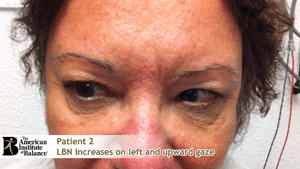
VIDEO: Eccentric Gaze Nystagmus: Importance in bedside Exam
Published on: June 28, 2013
Observation of spontaneous nystagmus is uncommon unless you are attending to a patient within several hours or days of an acute labyrinthine attack or suffering a CNS lesion. It may be even more difficult at bedside/chairside without the use of VOG goggles. For those practitioners less familiar with direct observation of nystagmus, eccentric gaze is a helpful assessment protocol. With patient’s gaze in the direction of the fast phase and even more so with an upward gaze, a low intensity nystagmus will enhance. The ocular motor muscles are in their weakest visoelastic state with upward gaze and it will release the nystagmus toward the fast phase (Alexander’s Law).
Here are videos of two patients, both of whom had experienced a single debilitating episode of vertigo accompanied by nausea and emesis. Medical and otologic evaluation and MRI were unremarkable. Both patients were diagnosed as probable vestibular neuritis in the absence of hearing loss or focal neurological symptoms.
You will see in the videos of each patient that there is a low-intensity direction fixed left beat nystagmus (LBN), suggesting the left ear is the stronger non-involved ear. The nystagmus significantly enhances on both leftward and upward-left gaze. In the absence of any additional medical recommendations, these patients were deemed to have a stabilized but non-compensated labyrinthine dysfunction (based on functional vestibular tests i.e. CTSIB, DVAT, and KRC). Each patient underwent a successful 3-4 week course of vestibular rehabilitation therapy (VRT).